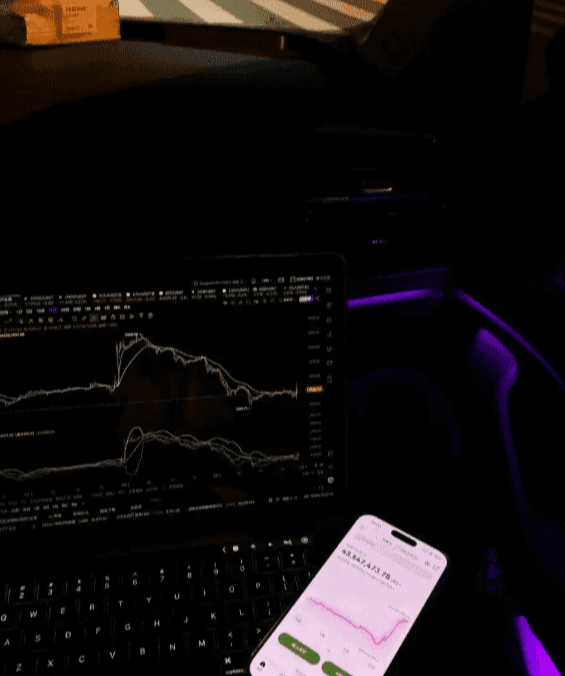After ten years of ups and downs in the cryptocurrency world, I started with an initial capital of 68,000 earned from working, and now I have accumulated over 40 million in wealth. I focus on spot trading and keep a respectful distance from contracts. Although I have not achieved a billion fortune starting from ten thousand like some legends, I am deeply satisfied, moving forward steadily, silently hoping that my account can cross the billion mark by the end of the year to pave the way for more capital next year.
On the journey through the cryptocurrency world, maintaining a calm mindset is crucial. In the face of severe market fluctuations, I do not let anxiety sway my emotions during downturns, nor do I get lost in temporary euphoria during upturns, knowing that taking profits is the way to safety. Looking back, when I first entered the cryptocurrency world, I often lost sleep due to worries, frequently waking up in the middle of the night. Now, I have learned to take it all in stride.
At its core, the way to make money requires skills, but what is even more valuable is adhering to a set of principles in your heart. Just this belief alone is enough to help me surpass many peers, eliminating at least 70% of them!

The most important thing in trading is to choose trend trading. There is a survey conclusion in technical analysis books.
Among 10 traders, those who profit steadily are trend traders.
So, for general matters, when doing trading, be sure to choose trend trading. Combined with the trading system mentioned earlier, it can definitely achieve stable profits.
This has been stated very clearly, setting trading norms for beginners. Even if you follow this as a beginner and still cannot make a profit, it’s better not to play.
Next, I will share the core strategies of trend trading. This is the essence of it, I can't explain it too detailed, so I'll keep some practical insights.
The framework of trend trading is as follows:
1. What is a trend, and how to determine a trend?
Everyone has different criteria for judging trends.
Let me briefly share mine.
For example, a breakthrough is considered to start the trend when the moving average M60 breaks.
For example, according to the trend standard, a high point is higher than a previous high point, and a low point is also higher than the last low point.
2. Trend trading entry methods
There are two common entry methods for trend trading:
First, enter at support levels, which means entering at pullback positions. The key question is how to determine whether this position is a pullback turning point. Common methods are trend line support levels, trend line support, and Fibonacci retracement levels.
Secondly, breakthrough entry, the most common is breaking previous highs, and a higher probability is breaking after being flat for a long time.
For advanced points, ponder high-probability support and breakout points more.

Why is it difficult for 90% of investors to make a profit?
The core lies in frequently making irrational decisions at the wrong time! Whenever the market experiences a pullback, many investors rush to sell like startled birds. If you ask them why they are selling, the answers are often shocking: "Everyone is selling, and if I don't sell, I'll lose big!" This kind of blind following behavior has long deviated from the essence of investing, merely a battle of wealth consumption under collective irrationality.
Global economic fluctuations seem complex and unpredictable but actually align with the underlying logic of capital operation. Whether it is geopolitical conflicts, cyclical economic crises, or sudden market panics, history is always remarkably similar, constantly replaying familiar plots:
The trading cycle of large institutions
Step 1: Create panic — institutions concentrate on selling, causing severe market fluctuations
Step 2: Retail stop-loss — investors panic and cut losses at low points out of fear
Step 3: Accumulate at low positions — institutions calmly take over, completing the collection of chips at low prices
The cruel truth of the market is:
Professional investors often decisively position themselves during crashes
Ordinary investors always chase highs and sell lows
Ultimately leading to wealth flowing from the majority to the minority
True investment wisdom should be:
A market crash is precisely the test for quality assets
Collective panic moments often contain excellent entry opportunities
Most profits are often concentrated in a few key holding phases
Please remember:
In the capital market
Short-term price fluctuations are driven by emotions
Long-term value return is determined by the fundamentals of the company

The rule of the poor's counterattack: either turn your fortune around or accept your fate
"If you don't have money, don't play in the cryptocurrency market? What a load of crap! I entered with 5000 bucks and rolled out a down payment in three years!"
Those who tell you "don't touch cryptocurrency without 100,000" deserve to be a vegetable forever. The cryptocurrency world is the last chance for ordinary people, and today's "beggar version of wealth strategy" is specifically for curing poverty!
First trick: Airdrop free-riding technique - zero-cost robbery of Wall Street
You think airdrops are free money? 99% of people can't even pick up the trash! But I made 30,000 dollars last year using this "matrix bombing method". Cost? 500 bucks!
Airdrop golden rule
Only invest in new projects within the top 50 by market cap (shitcoins waste time, better to sleep)
Operate with 5 wallets simultaneously (500 bucks cost, diversify risks)
Work from 3-5 AM (Gas fees are as cheap as free)
The first 30 days before the mainnet launch are a golden period (the project team is the most generous with money)
Second trick: Contract survival skill - either eat meat or eat dirt
100x leverage is meant for martyrs! The poor should prioritize survival over becoming rich!
My contract iron law
2000 capital split into 5 parts, only do key breakout points for BTC/ETH
5x leverage (even if it blows, it won't hurt too much)
Cut losses at 3% (60 bucks for a lesson)
Make 5% and run (monthly average return of 30% is great)
Buddhist approach: 3000 bucks, 3x holding coins, automatically stop-loss when breaking support
Gambling dog package: leave 500 bucks for the lottery
Zero? Just consider it a contribution to the exchange! But what if I hit a hundred-fold coin? (laughs)
Bloody lessons
Avoid altcoin contracts (poor liquidity, death from spikes)
Don't hold positions (90% of liquidations are due to 'waiting a bit longer')
Do not play when the Federal Reserve is making noise (too much volatility, easy to die suddenly)
My three no principles for shitcoins
Do not touch coins without an audit (99% are exit scams)
Avoid telegram groups without real people (all are robot projects = scams)
Do not touch projects with a market cap of over 100 million (limited growth potential)
The ultimate mindset for the poor to turn their fortunes around
Seize opportunities that others cannot understand (airdrops, shitcoins, early projects)
Use strategies that others dare not use (low-leverage contracts, diversified investments)
Retreat when others are greedy (take out the principal when doubling, let profits continue to roll)
Remember: In the cryptocurrency world, it does not matter how much capital you have, but how clear-headed you are. Either enter with a strategy or leave with dignity — at least the casino gives you free drinks, while the cryptocurrency world even charges for tears.

Today's sharing is for those friends in the cryptocurrency world who are still losing money and for beginners who have just entered the market. I hope this can help you, at least allowing new investors to avoid ten years of detours. In this field full of opportunities and risks, if you want to walk steadily on the investment path and achieve ideal results, it is necessary to deeply understand various investment strategies and techniques.
1: When preparing to enter the cryptocurrency market for investment, it is essential to be well-prepared. It's better to enter with a small initial amount than to blindly rush in. Proceed with caution and fully assess risks and your own risk tolerance.
2: When the coin price is at a low flat state and then hits a new low, this is an excellent time to buy heavily. At this point, the market may have hit the bottom and is expected to welcome a significant rebound.
3: When the coin price hits a high, one should promptly sell the chips in hand; when the price crashes, one should decisively enter. During flat phases, try to avoid trading, as the direction is unclear and the risks are high.
4: If the coin price remains flat, it usually means it might be a horizontal replacement for a decline. At this point, you should firmly hold onto the coins in your hand, as there could be a price surge at any time.
5: When the coin price experiences a rapid surge, always be prepared to sell, as such quick rises often come with the risk of sudden drops.
6: When the price of coins is slowly declining, it is a good time to gradually add to your holdings, which can lower the average cost.
7: In the face of high and low consolidation, first maintain patience and wait. This is one of the secrets of trading. Do not rush to operate to avoid unnecessary losses.
8: When the coin price is high and then surges again, seize this opportunity to sell quickly and take profits. When the coin price is low and then hits a new low, one should buy in fully, as this is a rare good opportunity.
9: When the coin price does not hit a high, do not sell; when the coin price does not crash, do not buy. Do not trade during flat periods. Following this principle can avoid many unnecessary risks.
10: Choose to buy on a bearish candle, and not on a bullish candle; sell on a bullish candle, and not on a bearish candle. Acting against conventional market thinking makes one a true investment hero. If the coin price surges in the morning, one should sell; if it surges in the afternoon, do not blindly chase; if it drops in the afternoon, consider buying the next day; if it drops in the morning, do not rush to cut losses. In cryptocurrency investment, maintaining calm and rationality and following these principles and strategies will help better respond to market changes and achieve investment goals.
The above 10 iron laws are also what I have personally experienced and summarized. I hope they can help those who are still losing money and new investors.